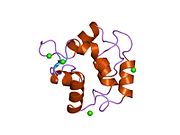Biology:Oncomodulin 2
From HandWiki
Oncomodulin 2, also known as OCM2, is a human gene that is similar to oncomodulin.[1]
Oncomodulin is a high-affinity calcium ion-binding protein. It belongs to the superfamily of calmodulin proteins, also known as the EF-hand proteins. Oncomodulin 2 is an oncodevelopmental protein found in early embryonic cells in the placenta and also in tumors.[1]
References
Further reading
- "The Ca2+(-)binding proteins parvalbumin and oncomodulin and their genes: new structural and functional findings.". Biochim. Biophys. Acta 1306 (1): 39–54. 1996. doi:10.1016/0167-4781(95)00221-9. PMID 8611623.
- "Calcium-binding proteins: distribution and implication in mammalian placenta.". Endocrine 19 (1): 57–64. 2003. doi:10.1385/ENDO:19:1:57. PMID 12583602.
- "The genes for the highly homologous Ca(2+)-binding proteins oncomodulin and parvalbumin are not linked in the human genome.". Genomics 12 (3): 567–72. 1992. doi:10.1016/0888-7543(92)90449-3. PMID 1559707.
- "Inhibition of glutathione reductase by oncomodulin.". Arch. Biochem. Biophys. 277 (1): 149–54. 1990. doi:10.1016/0003-9861(90)90563-E. PMID 2306116.
- "Disulfide-linked dimer of oncomodulin: comparison to calmodulin.". Biochemistry 27 (15): 5615–22. 1988. doi:10.1021/bi00415a033. PMID 3179268.
- "A complete complementary DNA for the oncodevelopmental calcium-binding protein, oncomodulin.". J. Biol. Chem. 262 (11): 5308–12. 1987. doi:10.1016/S0021-9258(18)61189-5. PMID 3558395.
- "The widely-distributed tumour protein, oncomodulin, is a normal constituent of human and rodent placentas.". Cancer Lett. 27 (2): 145–51. 1985. doi:10.1016/0304-3835(85)90103-X. PMID 4005827.
- "Calmodulin-like effect of oncomodulin on cell proliferation.". J. Cell. Physiol. 160 (3): 455–62. 1994. doi:10.1002/jcp.1041600308. PMID 8077283.
- "Human alpha and beta parvalbumins. Structure and tissue-specific expression.". Eur. J. Biochem. 215 (3): 719–27. 1993. doi:10.1111/j.1432-1033.1993.tb18084.x. PMID 8354278.
- "Oncomodulin is expressed exclusively by outer hair cells in the organ of Corti.". J. Histochem. Cytochem. 46 (1): 29–40. 2000. doi:10.1177/002215549804600105. PMID 9405492.
- Sanger Centre, The; Washington University Genome Sequencing Cente, The (1999). "Toward a complete human genome sequence.". Genome Res. 8 (11): 1097–108. doi:10.1101/gr.8.11.1097. PMID 9847074.
- "Creation of genome-wide protein expression libraries using random activation of gene expression.". Nat. Biotechnol. 19 (5): 440–5. 2001. doi:10.1038/88107. PMID 11329013.
- "Generation and initial analysis of more than 15,000 full-length human and mouse cDNA sequences". Proc. Natl. Acad. Sci. U.S.A. 99 (26): 16899–903. 2003. doi:10.1073/pnas.242603899. PMID 12477932. Bibcode: 2002PNAS...9916899M.
- "The DNA sequence of human chromosome 7". Nature 424 (6945): 157–64. 2003. doi:10.1038/nature01782. PMID 12853948. Bibcode: 2003Natur.424..157H.
- "The Status, Quality, and Expansion of the NIH Full-Length cDNA Project: The Mammalian Gene Collection (MGC)". Genome Res. 14 (10B): 2121–7. 2004. doi:10.1101/gr.2596504. PMID 15489334.
- "Solution structure of human beta-parvalbumin and structural comparison with its paralog alpha-parvalbumin and with their rat orthologs". Biochemistry 43 (51): 16076–85. 2005. doi:10.1021/bi048388o. PMID 15610002.




